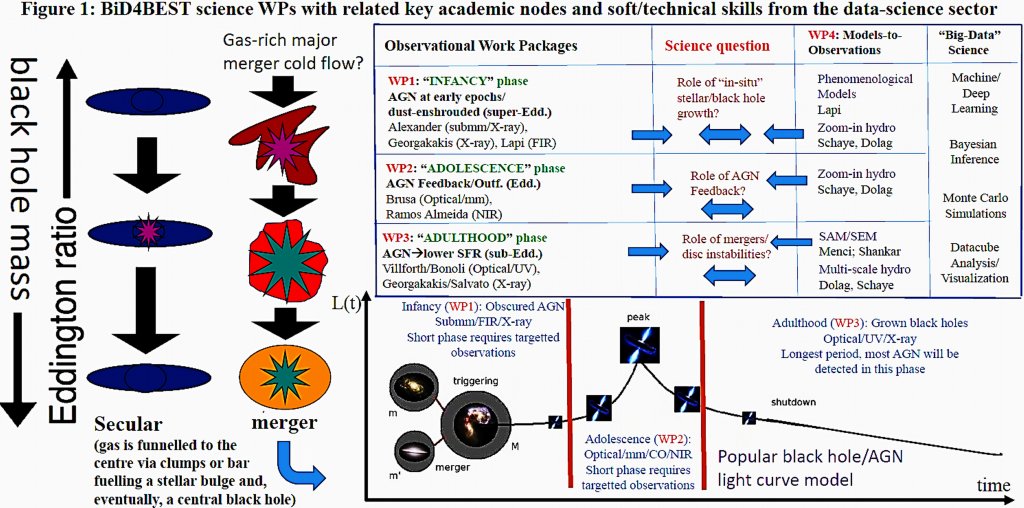The last 20 years have witnessed a paradigm shift in the way the scientific community approaches two fundamental questions of astrophysics; how do galaxies evolve, and what are the processes responsible for the formation of black holes?
Observations revealed that supermassive black holes of a million to a billion solar masses are lurking in the cores of most galaxies, including our own Milky Way. Unexpectedly tight correlations have been discovered between the masses of these black holes and mass proxies of the stellar component of the host galaxy bulges. This is remarkable given the large difference in the scales involved. The stellar component of galaxy bulges extends to distances 100 to 1000 times larger than the gravitational sphere of influence of the central black hole. The very existence of these correlations suggests that the galaxy bulges and the supermassive black holes at their centres share a common evolutionary history, which remain elusive. It is of paramount importance to understand how supermassive black holes form to have a complete picture of galaxy evolution and, vice-versa, the growth of black holes at the centres of galaxies can only be studied in the context of galaxy formation. The research field of black-hole and galaxy (co-)evolution has expanded dramatically in recent years bolstering with new observational and theoretical evidence on the relation between black holes and galaxies.
In popular, but still highly debated, models, a supermassive black hole rapidly grows via gas accretion within a highly star forming, gas-rich, dust-enshrouded galaxy (infancy), possibly triggered by a merger and/or cold flow. The dust-enshrouded black hole grows, shining as an (X-ray/IR) Active Galactic Nucleus (AGN), and possibly launching powerful winds (adolescence). Around the peak of the AGN light curve such winds may halt star formation in the host galaxy via removal/heating of the gas (AGN feedback), self-regulate black hole growth, ultimately setting the scaling relations with its host galaxy. The host then transitions from a dusty, IR/submm galaxy, to an optical/UV quasar (adulthood), eventually fading into a low star forming galaxy. This popular evolutionary picture needs to be framed against orientation models in which obscured AGN are strictly those sources viewed close to edge-on, where more dust resides. Additionally, besides mergers, secular processes (disc/bar instabilities) may also be efficient triggers of bulge and black hole growth. Many AGN seem to be associated with non-merging galaxies.
The BiD4BEST project is structured in four distinct scientific work packages:
Work Package 1 – (infancy) What is the link between (high) star formation and (early black hole growth, and what is the role of orientation in AGN obscuration?
Work Package 2 – (adolescence) Is AGN feedback occurring and playing any relevant role in shaping galaxies and their scaling relations with black holes?
Work Package 3 – (adulthood) What is the physical link between galaxy morphology/environment and AGN triggering?
Work Package 4 – (models to observations) How do state-of-the-art theoretical models compare with state-of-the-art observational data?

Answering these questions requires gathering large data sets in different wavebands capable of probing the different black hole evolutionary phases. X-ray observations, due to their unique sensitivity can identify AGN among galaxies over a wide range of accretion luminosities, cosmic distances, and levels of obscuration. The most heavily obscured AGN can be detected at mid-infrared wavelengths, where the obscuring dust thermally peaks. UV/optical data continue providing very large samples of AGN at their peak and/or decaying phase. A comprehensive picture can therefore only be obtained by merging AGN samples selected at different wavelengths, with shallow wide-area and deep pencil beam surveys. Multiwavelength wide/deep AGN surveys, properly de-biased by multiple selection effects and compared to the latest numerical, analytic and phenomenological cosmological models, will be the main focus of BiD4BEST.

